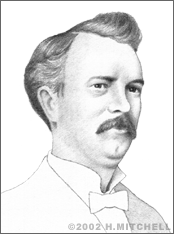William Burroughs
William Seward Burroughs, inventor of the first workable adding machine, was born in rural New York in 1855. In the 1870s, he was working as a bank clerk at the Cayuga County National Bank in Auburn, New York, where he became interested in solving the problem of creating an adding machine. There had been a number of earlier prototypes, but, in inexperienced users’ hands, those that existed would sometimes give incorrect, and at times outrageous, answers.
In St. Louis, Missouri in the early 1880s, Burroughs was working for the Boyer Machine Company, where he began designing his own adding machine prototype. His design included a “dash pot,” or a mechanism that regulated the pull on the machine’s handle. He was granted a patent for the device in 1888. Two years before the patent came through, he founded the American Arithmometer Company company with three other men—Thomas Metcalfe, R.M. Scruggs, and W.C. Metcalfe—to produce and sell the machine. The straight adding and listing machine Burroughs had invented was the company’s only product. Its purchase price was $475.00.
By 1887, American Arithmometer had manufactured 50 machines. However, Burroughs was the only one who could operate them correctly. Thus, the machines were recalled and Burroughs invented a corrective automatic device. In 1895, sales climbed to 284 machines. That year, Burroughs Adding and Registering Company was established in Nottingham, England, marking the company’s first entry into the international marketplace.
Between 1895 and 1900, business really took off. Sales jumped to 972 machines. Sadly, Burroughs, who had suffered a lifetime of chronic health problems, died in Citronelle, Alabama, on September 14, 1898. He was just 43 years of age. William Joseph E. Boyer, a St. Louis manufacturer who had supported Burroughs’ efforts for many years, became president of the American Arithmometer Company in 1902.
In 1904, the company moved to Detroit, where it built a 70,000 square foot plant. That year, the company’s name was changed to the Burroughs Adding Machine Company. For the next fifty years, Burroughs grew into the largest adding machine company in the United States. It introduced new products, including variations of the basic adding machine, typewriters, check protectors, and ticketeers.
In 1953, the Burroughs Adding Machine Company was renamed the Burroughs Corporation, a name more reflective of their broad scope of products, which began to include computers. In 1986, Burroughs Corporation merged with Sperry Corporation to form Unisys Corporation. The Burroughs family’s legacy lived on not only through William Seward Burroughs, his adding machine fortune, and the Unisys Corporation, but also through his late grandson William Seward Burroughs, the novelist, who died in 1997.


